Anna Roller’s Dead Girls Dancing (a highlight in the International Feature Film Competition of the 22nd edition of the Tribeca Film Festival) stars Luna Jordan, Noemi Liv Nicolaisen, Katharina Stark, and Sara Giannelli on the road looking for adventure. Sofia Coppola’s The Virgin Suicides and Bling Ring, as well as Harmony Korine’s Spring Breakers may flash through your mind at times, but you’ll soon discover that this journey is distinctly of this century’s fiery Twenties.
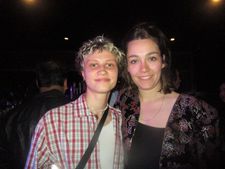 |
| Anna Roller with her Dead Girls Dancing star Luna Jordan at the Tribeca Festival Awards Photo: Anne-Katrin Titze |
Friends Ira (Jordan), Ka (Nicolaisen), and Malin (Stark) are recent high school graduates from Munich, and we first encounter them all dressed up, posing for photos, holding their diploma and a rose. Family members tell them how proud they are and questions are asked about the plan for the new life they are about to embark on, which turns out to be for now an improvised summer vacation in Italy.
A smell of burning fields and a wildfire in the distance speak of the times we live in (Christian Petzold’s latest film Afire and the toxic air in New York City on the Opening Night of Tribeca back this up). Speech patterns and mood are unmistakably those of 18-year-olds right now, while anyone who travelled by car to Italy from up north in the last century will recognise the sheer endless amount of tunnels and the ever surprising vistas one discovers when emerging into daylight from the dark of the mountains.
After their car breaks down and they picked up a hitchhiker who calls herself Zoë (Giannelli), they end up in a village which seems to be completely devoid of people, despite signs of recent human activity everywhere. Soon the four girls treat this fantastic location as their own private playground, wondering what possible enchantment brought them here. Trying on fur coats they find in the closet of an abandoned apartment, they resemble the girls in Tara Subkoff’s #Horror and evoke many a dress-up game among girlfriends in cinema and beyond.
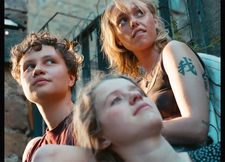 |
| Ira (Luna Jordan), Ka (Noemi Liv Nicolaisen), and Malin (Katharina Stark) in Dead Girls Dancing |
Has the community been ravaged by a mysterious plague? Did they coincidentally enter a magical realm? Has the apocalypse happened and they were spared? After ransacking the local supermarket and discovering the mess wine, they drunkenly dance in church. Among them new bonds emerge and homegrown attitudes solidify. One bad decision often leads into another, and we never actually know what is what or where actions lead. Dead Girls Dancing is a bright reminder that when you were told at a young age how anything was possible, that “anything” never quite turned out to be what you imagined.
From the Tribeca Festival hub, Anna Roller joined me on Zoom for an in-depth conversation on Dead Girls Dancing.
Anne-Katrin Titze: Hello Anna!
Anna Roller: Nice to meet you!
AKT: You had your premiere last night! How was it?
AR: It was really great. It was a nice screening; I was really nervous and excited. It was a really nice audience.
 |
| Sofia Coppola arrives to present The Virgin Suicides at First Time Fest in 2013 Photo: Anne-Katrin Titze |
AKT: Good to hear! Your film has, especially at the beginning, the feel, almost, of a documentary, for the tone, the language. It made me think that maybe in 20 years - if we make it that long - people will look back and say: This is what 18-year-olds in Munich in 2022/2023 sounded like. Did you want to capture some of the moment like that?
AR: That’s really nice of you to say! Yeah, for me it was really important to take the girls seriously and to create a film where they can have a very naturalistic acting style. In the beginning we had a long rehearsal process so they could get to know each other very well. We also rehearsed scenes that are not in the movie so that we could get the base of their friendship.
While shooting we often had the scenes start earlier and go longer than they were in the script so that it almost had this improvised style to it. I didn’t want to shoot an improv-movie, I just wanted to give them a lot of freedom and sometimes when we had the perfect take, I did the opposite take after it to always keep it alive.
And I was working with an editor [Mila Zhluktenko] who is a documentary director herself so that’s what I discussed with her before shooting - that I would collect a lot of material with the girls, although we had a very strict schedule and scenes, to get this feeling of a bunch of material that we then use to create the movie afterwards. To really look at the material from a documentary perspective.
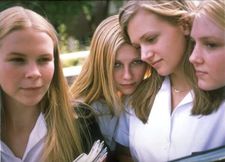 |
| Anna Roller on Sofia Coppola: “What I love about her and what is perhaps a parallel is that we both love telling stories of female characters that do something maybe unlikable.” |
AKT: There are these lovely details you caught. Grandma has lipstick on her teeth, for example!
AR: Yeah!
AKT: By chance? Did you put it on her teeth?
AR: The lipstick is by chance but I think this comes from working closely with my DP [Felix Pflieger] that if I see something like this, I go “okay, let’s get that!” Also all the animals that are in the movie, it was always something we knew we needed - images that make it a movie where you can feel everything, smell everything.
AKT: The black sheep for example?
AR: The black sheep!!! I didn’t tell the black sheep to do that!
AKT: It’s great. I recently saw Christian Petzold’s Afire. Have you seen it?
AR: I have seen it.
AKT: He mentioned that Germany is not famous for summer vacation movies [ever since Menschen am Sonntag - People on Sunday from 1930, directed by Robert Siodmak and Edgar G Ulmer, story by Billy Wilder, and Fred Zinnemann as assistant cinematographer]. And here at Tribeca are two. Very different ones but with some overlaps. There are wildfires and cars breaking down in both.
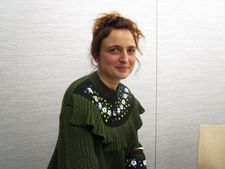 |
| Anna Roller: “I’m a huge fan of Alice Rohrwacher. We actually shot very close to where she lives.” Photo: Anne-Katrin Titze |
AR: That’s so interesting that he said that and you mention it, because I met someone from German Films and they are making a collection of German Summer Movies. I guess Petzold’s film is going to make it. I didn’t know about the film until I saw it, but the parallels are really obvious and really interesting because it’s also very different young people.
AKT: Totally!
AR: When I started writing there were the wildfires in Australia and we got a lot of news from Italy and Spain all the time, so this feeling of apocalyptic news came closer and closer and closer and I guess inspired both of us.
AKT: And then here, you come to Tribeca and the air looks like this, with a burnt orange sun [worse than ever, from what we were told were Canadian wildfires]! When did you arrive?
AR: On Tuesday [June 6]. We arrived on the worst day. It was weird because it’s literally like the same. A group of people go on a trip; they come there and suddenly it feels like the world’s ending. It was absurd.
AKT: When I spoke with the Artistic Director Frédéric Boyer about what’s coming up in Tribeca, he mentioned your film and said it’s a bit like Luca Guadagnino meets The Virgin Suicides by Sofia Coppola. I did not really see these two in your film. What do you think of those comparisons? Are there filmmakers whom you admire? Two part question!
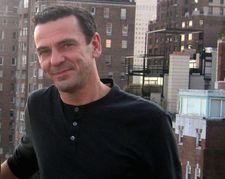 |
| Anna Roller on Christian Petzold’s Afire and Dead Girls Dancing: “I didn’t know about the film until I saw it, but the parallels are really obvious …” Photo: Anne-Katrin Titze |
AR: Sofia Coppola has a very different style than I have, but what I love about her and what is perhaps a parallel is that we both love telling stories of female characters that do something maybe unlikable. Or maybe something that you wouldn’t understand right away and then the film tries to make you understand why they act that way. And Luca Guadagnino, I mean …
AKT: Let’s say there’s no cannibalism in your film. Any filmmakers that are particularly close to your heart?
AR: Yes, but not as an inspiration for this movie. I’m a huge fan of Alice Rohrwacher. We actually shot very close to where she lives. We met some crew of hers in Civitella d‘Agliano where we shot. She’s really important to me and all the female filmmakers with this very distinctive style, like Andrea Arnold and Kelly Reichardt. I really look up to them.
AKT: Alice is wonderful, I love her too. The story of your film, we really don’t know which genre this is going to turn into. Someone mentions the three witches from Macbeth. We also get a sense that your characters’ behaviour is something that children do. I am shuddering now thinking about it, but my girlfriends and I were going into abandoned villas to poke around. It’s terrifying now, but I was reminded of these “explorations” during childhood. Which part was the original spark for the story?
AR: The original idea was really the character of a girl that’s at a point where she has all the possibilities and is really overwhelmed by this and is very mature in a way and very childish in a way. Very naïve and romantic almost. For me it’s like she is looking for a place and the movie is looking for its place as well. It’s going into this fantasy of the girl and then it comes to reality, so I tried to have magical sparks in it but not make it a genre movie.
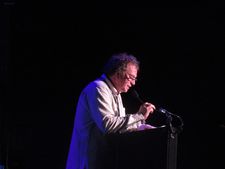 |
| Tribeca Film Festival Artistic Director Frédéric Boyer announcing the International Feature Film Awards Photo: Anne-Katrin Titze |
AKT: The idea of a gun entering the picture surprised me. Did you always know that a gun was going to come in?
AR: It wasn’t there in the very first version. We always see guys and young boys playing with guns a lot. I was really interested in how this object changes the whole energy in the room. It’s never fired, we don’t even know if it works; we don’t know if the girls know how it works. So it’s just this object that’s really dangerous and changing ….
AKT: … the dynamics and ultimately everything.
AR: Yeah, and I was interested in seeing it have the same effect on girls as it has on boys.
AKT: When they go into the supermarket it feels a bit like Spring Breakers wreaking havoc. The church scenes are also interesting and quite blasphemous. Tell me about these decisions!
AR: Of course for me all these girls have seen Spring Breakers. These girls have seen films like this. I wanted to show that they have these versions of themselves and what to copy in a way. And with the church scenes, they are behaving incredibly disrespectful. What I wanted to explore is young women who are like not believing at all in the church.
At least my experience is that people my age or the next generation many of them really don’t want to have anything to do with the church. But in a way through the whole movie Ira is looking for something to believe in. She wants to believe in something supernatural or something spiritual and is on a search for that.
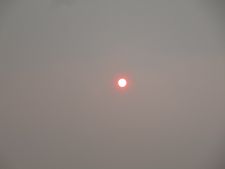 |
| New York City on Tuesday, June 6 Photo: Anne-Katrin Titze |
AKT: In some respect it comes full circle in the end. Also interesting is the doubling of photos being taken in the beginning and in the end albeit under very different circumstances. The question of adulthood and childhood comes up.
There is a folktale the Brothers Grimm collected, a tale they omitted when it became an edition for children in 1819, called How Some Children Played At Slaughtering [Wie Kinder Schlachtens Miteinander Gespielt Haben - source: Heinrich von Kleist, Abendblatt 1810]. It’s about children playing and not being aware of the consequences; or maybe they are, that’s the question. There’s a bit of that in the end with Ira. We don’t know where she is because she might not really know where she is.
AR: Yes, and the irony is that probably she wants to be seen as a kid in front of the law in the end because that would make things easier. I like that this question comes up again in the end. We always feel that she wants to be seen as an adult and is really an old soul as well. But there’s something naive and childish about it. I think she’s matured in the end. It almost ends on a magical note. She brings back her childish side or her vulnerable side. She hasn’t grown up all of a sudden in the end and I think that’s good.
AKT: And the sheep come back at the very end too! Are you working on a new movie?
AR: Yes, I’m actually working together with the production company Pelacoda Film and Totem Films as well, so it’s going to be a French-German coproduction.
AKT: Everything else will have to be a surprise?
AR: Yes, I think I’m not allowed to say more. But it’s about a mother-daughter relationship, about a phase of transformation again, but at the other end of the circle in a way.
AKT: Thank you so much for this! Very interesting movie!
AR: Thank you so much!






















